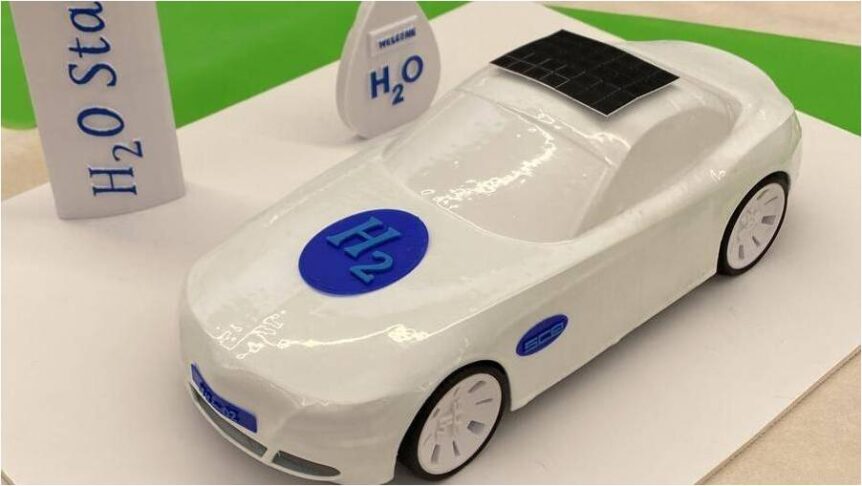Can we make green hydrogen (or other energy sources) from scrap we otherwise throw away? One of the frequently announced “breakthroughs” recurrently finding its way to our attention is that scrap food or farm waste has found its way to becoming aviation fuel, for instance. United and Alaska Airlines have flown aircraft powered by biofuels produced from food waste by suppliers at SEATAC airport in Seattle, Washington. Hydrogen is undergoing a growth spurt. The U. S. Department of Energy explains, “Hydrogen is an energy carrier that can be used to store, move, and deliver energy produced from other sources.” Green hydrogen seems to be an answer to many demands. It comes from splitting water, and if produced through clean means, is a carbon neutral to carbon negative product. Stainless Steel Powder and Water Dr. Guy Ben Hamu, Head of the Department of Mechanical Engineering at Sami Shamoon College of Engineering, explains the process uses H2 trapping, something usually related to …
Wright Electric’s 8-Year Plan
Jeffrey Engler has headed up Wright Electric for the last decade, working to provide efficient motors, inverters and overall power systems for airliners. Now, his firm is working to develop those airliners. From a startup in 2016, looking for a single-engine light aircraft to convert to hybrid power, Jeffrey has grown Wright to a recognized force in future flight. Presenting a mission statement and schedule for the next eight years, Wright has ambitious, but reasonable plans. Currently, Wright is testing a two megawatt motor and inverter, “Collaborating with NASA, U.S. Department of Energy, and U.S. Department of Defense.” Testing will continue through 2023. The firm predicts it will be flying its Wright Spirit between the busiest “city-pairs” in the world by 2026. The Spirit, a BAe 146 converted to electric power, will connect paired destination such as, “Seoul-Jeju, London-Paris, Rio de Janeiro-São Paulo, and San Francisco-Los Angeles.” “Wright’s goal is to make all single-aisle flights shorter than 800 miles zero-emissions,” …
BioLEC – First There was Light, Then There Was Energy
Feature image credit: Victor Tangermann Futurism ponders, “Sugar, Light, And A New Type of Chemistry — What It May Take To Wean Us Off Fossil Fuels” in an article by Dan Robitzki. The topic brings a new term into your editor’s vocabulary – BioLEC – Bioinspired Light Escalated Chemistry. The goal of such chemistry is to use the energy of two photons, “the tiniest quantifiable units of light, to power chemical reactions.” This takes us into how trees and other photosynthesizing plants use quantum theory to make things grow. Trees Have Been Doing it For Years It’s a bit odd to think of trees and quantum physics in the same sentence. Your editor used to think of sunlight striking leaves and chemistry taking place in a leisurely way inside while the tree or bush grew. It turns out that things take place at light speed inside the tree, with quantum activity in abundance. Outdoing Mother Nature? Researchers have tried to …
Nissan’s SOFC Vehicle – Just in Time for the Olympics
Two major types of fuel cells vie for vehicle designers’ attention: PEM, or proton exchange membrane types, and solid oxide fuels cells (SOFCs). PEMs (also known as polymer electrolyte membrane fuel cells) require an expensive catalyst such as platinum, and hydrogen as fuel. Hydrogen itself is costly to produce and runs up the operating cost for such a fuel cell. Nissan Motor Co., Ltd. timed things to coincide with the 2016 Olympics opening in Rio de Janeiro, Brazil for the introduction of their solid oxide fuel cell vehicle, a van that runs on bio-ethanol electric power. Nissan’s Carlos Ghosn claims this to be a first, with benefits for potential users. “The e-Bio Fuel-Cell offers eco-friendly transportation and creates opportunities for regional energy production…all the while supporting the existing infrastructure. In the future, the e-Bio Fuel-Cell will become even more user-friendly. Ethanol-blended water is easier and safer to handle than most other fuels. Without the need to create new infrastructure, it …
H2 – Many Benefits, Many Challenges
The benefits of hydrogen are fairly obvious. It would almost necessarily be a domestically produced material with few environmental shortcomings if made by clean processes. The challenges to be overcome are many and varied, though – with the biggest obstacle to wide-spread use being in the distribution of the fuel. The U. S. Department of Energy, on its Fuel Economy.gov web site, concedes, “The current infrastructure for producing, delivering, and dispensing hydrogen to consumers cannot yet support the widespread adoption of FCVs (fuel cell vehicles).” As different strategies are tested and adopted, this is likely to change, as are the costs for fuel cells and their longevity. Auto makers, working to bring FCVs to market, have dropped prices from the million dollar estimate for a Honda Clarity at its introduction to a few lucky individuals in 2008 to the projected $50,000-$100,000 price range at which its successor, the FCV, might be introduced today. The same type of controversy surrounds this …
Suppressing Those Pesky Dendrites
Dendrites in the human body are tree-branch-like protuberances that help transmit synapses, defined as tiny transmitters and receivers for chemical messages between the cells. In this setting they are beneficial and necessary for brain and nervous system development. In batteries, however, such protuberances send mixed and negative messages that short out connections between the components of the host battery. This is a serious enough issue that it’s kept lithium-metal batteries from serious development, dendrites growing between dissimilar metals being a malady of such cells, and even causing fires that make lithium batteries a bit fearsome. The blog has reported on efforts by Berkeley Lab researchers to reduce dendrite growth. To enable visualization of these growths, Clare Grey, a professor of chemistry at Cambridge University, teamed up with NYU chemist Alexej Jerschow to develop a way of imaging batteries through magnetic resonance imaging (MRI). As Popular Mechanics explained in 2012, “These moss-like crystalline growths, called dendrites, are the bane of battery builders. …
Electric Tugs at Sea-Tac Lower Costs, Emissions
Green Air Online reports that Seattle-Tacoma Airport (Sea-Tac) has launched a “$31 million project to provide nearly 600 electric charging stations for ground support equipment (GSE) such as baggage tugs, bag ramps and pushback vehicles.” Besides saving “around $2.8 million in airline fuel costs,” the conversion will reduce greenhouse gas emissions around 10,000 tons per year. Alaska Airlines will swap 204 fossil-fuel burning GSEs to electric and its partner Horizon Airlines will trade in 58. More airlines are going to join the program later this year. Federal grants and funding from the U. S. Department of Energy (DOE) and the Federal Aviation Administration (FAA) sweeten the transition for participants. “This project provides the infrastructure for airlines to convert their vehicles from diesel to electric in Sea-Tac’s effort to become the first major airport in the US to provide charging stations at all gates,” said Courtney Gregoire, Co-President of the Port of Seattle Commission. “As many as 650 vehicles could eventually …
Dendrites Grow Like Kudzu
Getting your fiber is a good idea for digestion and general health, but what if those fibers get you first? Or at least destroy your battery? This is the situation as described by a report from the U.S. Department of Energy (DOE)’s Lawrence Berkeley National Laboratory (Berkeley Lab), in which the writer tells us that dendrites are hairy little lithium fibers that “sprout from the surface of the lithium electrode and spread like kudzu across the electrolyte until they reach the other electrode.” These 3D reconstructions show how dendritic structures that can short-circuit a battery form deep within a lithium electrode, break through the surface and spread across the electrolyte. Besides resembling a fast-growing invasive plant, the dendrite bridge across the electrodes can cause an internal short circuit and possible fires in the battery, making dendrites extremely unwanted intruders. Because they pop up from the surface of electrodes, dendrites might easily have been understood as a surface phenomenom. Nitash Balsara, …
Cheap and Dirty Fuel Cells – Good News for Hydrogen
Hydrogen fuel cells would be just about the most wonderful power producers in the world if they weren’t so expensive and so finicky about their diet of hydrogen. Their catalysts, usually made of costly platinum, can be destroyed by impurities in the gas. Making high-purity hydrogen is an exacting task and adds to the expense of operation. Two studies by scientists at the U.S. Department of Energy’s (DOE) Brookhaven National Laboratory; one in conjunction with researchers at South Korea’s Ulsan National Institute of Science and Technology (UNIST), Korea Institute of Energy Research (KIER), show that it may be commercially possible to make less expensive catalysts with available materials, and in one case, use “dirty” hydrogen that would otherwise destroy fuel cells. The reduced price of making such hydrogen would further add to operational economies. Green Car Congress reports that Brookhaven and UNIST have discovered, “a new family of non-precious metal catalysts based on ordered mesoporous porphyrinic carbons (M-OMPC) with high …
Transformative EV Range Expansion?
In what may be eventual good news for future electric aviators, the U. S. Department of Energy (DOE) Advanced Research Projects Agency – Energy (ARPA-E) will award approximately $36 million to 22 projects to develop transformational electric vehicle (EV) energy storage systems using innovative chemistries, architectures and designs. ARPA-E also uses the term, “revolutionary.” The series of awards is part of the RANGE program (Robust Affordable Next Generation Energy Storage Systems), intended “to enable a 3X increase in electric vehicle range (from ~80 to ~240 miles per charge) with a simultaneous price reduction of > 1/3 (to ~ $30,000). If successful, these vehicles will provide near cost and range parity to gasoline-powered ICE vehicles, ARPA-E said.” “Transformational” comes straight from the CAFE phrase book, a hoped-for direction that goes beyond evolution to revolution in what comes next. A 3X battery at 1/3 the price would certainly be transformational, especially in aircraft use, making even ultralights plausible, and Light Sport Aircraft truly functional. …




